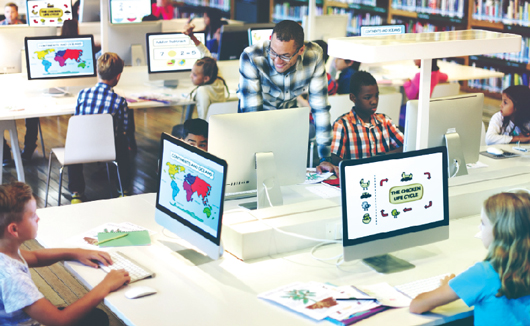Technology’s Growing Role in Education
How Atlanta’s Classrooms Are Changing in the Digital Age

By Larry Anderson
Greater use of technology at private and public schools is changing
how students learn. More innovation in the classroom also prepares students to prosper in a world where technology rules. The Atlanta area is full of examples of technology’s growing role in education. At McGinnis Woods Country Day School in Alpharetta, middle school students are assigned laptops and folders on a server. At The Friends School of Atlanta, students build and program LEGO robots. At The Piedmont School of Atlanta, interactive projectors and whiteboards help students reach their academic potential and meet social and emotional needs. At Woodward Academy, students in primary grades learn foundational skills in technology, robotics, coding and general computer skills.It Starts at an Early Age
Technology is integrated into every element of education these days. At High Meadows School in Roswell, for example, Technology Integration Specialists partner with all homeroom teaching teams to enhance students’ learning and experiences through technology. Even early years students (pre-school through second grade) carry iPads outside to take pictures of the wide variety of caterpillars on campus. Then they research the caterpillars, and use a diagram app to show what butterflies each turns into. Students in fifth through eighth grades learn to program a 3D printer and design objects. One student, for example, designed educational braille chips that looked like dominoes.
Every kid likes video games such as Minecraft, and now video games are finding their way into the classroom. Also at High Meadows, an innovative Minecraft music program was created by music director Paula Williams. It uses the popular video game to help students master the nuts and bolts of music. High Meadows was one of 100 schools in 30 countries to beta-test Minecraft’s new Education Edition. “I love the multi-age collaboration and excitement that Minecraft brings to learning,” says Williams.
‘Continually Adding Technology’
At McGinnis Woods Country Day School in Alpharetta, students have access to technology at all grade levels. Teachers use interactive whiteboards to introduce and reinforce new concepts. Students use technology to complete Web quests, and work on skills through software and websites such as IXL Learning or Pearson Education resources. Students create presentations beginning in the first grade, and also spend time with robotics and simple programming. “We are continually adding technology to our classrooms,” says Mary Johnson, principal of McGinnis Woods.
“In the middle school we use technology in every one of their core classes,” says Johnson, using assigned laptops and folders on the server. In line with an emphasis on STEM [Science, Technology, Engineering and Math] learning, students build and program robotics, and the parent association recently purchased a 3D printer. Johnson emphasizes the importance of staff training and development to support use of technology and wise use of technology funds.
Across Disciplines and Concepts
The Friends School of Atlanta integrates technology into the Innovation Lab to help students engage in critical thinking and problem-solving activities while learning concepts of science, mathematics and engineering. “It’s a fun and collaborative environment where there are no wrong answers,” says Jennifer Wardell Smith, the school’s innovation teacher.
Students involve themselves with hands-on projects to build creations such as a LEGO robot programmed to sound an alarm when someone nears their computer or a video game to educate users about a social issue or injustice. Class activities are designed across a variety of disciplines and concepts, all encouraging hands-on engagement, experimentation and exploration. The Friends School of Atlanta also has a “1:1 program”—each student receives a Chromebook computer.
Technologies such as interactive projectors and whiteboards and collaborative and assessment software are being implemented at The Piedmont School of Atlanta, an independent school serving high-achieving children with autism and other learning and social challenges. Technology provider Boxlight Corp. has designated The Piedmont School as a national demonstration school and provided a range of instructional technologies to help students in pre-kindergarten through ninth grade reach their academic potential and fulfill social and emotional needs. Dr. Catherine Trapani, head of the school, says The Piedmont School of Atlanta will be showcasing “an incredibly engaging and motivating learning environment and powerful instructional strategies [using the technology].”
Engaging and Just Plain Fun
At Woodward Academy, technology helps students learn to think critically, collaborate, and solve real-world problems involving STEM disciplines. In the classroom, technology can be engaging and just plain fun. It can be used to differentiate instruction to provide opportunities for students to learn in a variety of ways. Woodward Academy seeks to “meet students where they are.”
Technology implementation at Woodward Academy includes a K-12 programming/coding curriculum, a sustainability curriculum, a global scholars program, school MakerSpaces, drone and robotics teams, and an emphasis on design thinking and project-based learning. MakerSpaces are areas where students can gather to create, invent and learn through tinkering and building in a fun environment.
The library is no longer just a place to check out books—it’s a community learning hub, and technology plays a role. The Woodward Academy Primary School Collaboratory invites students to explore, design and create. Tinkering fosters curiosity, and failure becomes opportunity. It can be as complex as programming robots.
At Woodward North, a learning space called Eaglesphere serves as the center for STEM programming and design thinking. A small group might conduct research in the extended Learning space, and a coding class might be working in the Engineering Lab, while small groups work at Collaboration stations. Learning labs, computers, and the latest student-centered learning tools and applications are employed. Also at Woodward North, students in primary grades attend weekly classes to learn foundational skills in subjects such as technology, robotics, coding, and general computer skills.
Rapid technological advancements are changing the way we all interact, communicate and access information. No surprise that educators are incorporating those advancements into the classroom. By using an array of computerized devices and programs, they create better interactive learning environments, while offering students a greater understanding of the technology they use every day.








